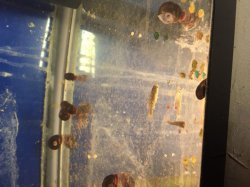chrissfishes
Fish Fanatic
- Joined
- Feb 16, 2010
- Messages
- 119
- Reaction score
- 2
I thought it would be great to start up a breeding/keeping log. To share your experience keeping species of livebearers for other aquarists to learn about species. Please share your experience keeping species and please share pictures.
My log will be about keeping Xenotoca melanosoma "Rio Ayuquilla" and distinct species Xenotoca melanosoma "Granja Sahriupa". I just got a small group of Granja Sahriupa from the ALA convention. They are still young fry so it will be A while before they mature enough to breed. I have pictures of the fry and Rio Ayuquila fry.
I have been keeping the Rio Ayuquila since the spring of 2013. They are the true melanosoma and are possibly extinct in the wild. They are very hardy fish and full of personality. Very active and can get somewhat aggressive during mating seasons. They breed twice a year (spring and fall). They seem mature enough to breed around 6 months old. Depending on how old the female is will determine around how many fry she will have. Young female usually around 8 and when she is an adult can have around 30 fry. They will eat their own fry so it's best to either remove the fry immediately when you see them or net the female when she is gravid and put her in an aquarium all by herself.They will eat anything. I feed them flakes and a variety of frozen foods. I do 50% water changes bi-weekly and let the temperature of the tank go by room temperature. I don't use heaters. A 3ft tank is probably best to keep a colony of melanosoma.
I'll keep updating how things are going with the melanosoma. Please share your experience

Two in the bare tank are Granja Sahriupa and the other two in a planted tank are Rio Ayuquila
My log will be about keeping Xenotoca melanosoma "Rio Ayuquilla" and distinct species Xenotoca melanosoma "Granja Sahriupa". I just got a small group of Granja Sahriupa from the ALA convention. They are still young fry so it will be A while before they mature enough to breed. I have pictures of the fry and Rio Ayuquila fry.
I have been keeping the Rio Ayuquila since the spring of 2013. They are the true melanosoma and are possibly extinct in the wild. They are very hardy fish and full of personality. Very active and can get somewhat aggressive during mating seasons. They breed twice a year (spring and fall). They seem mature enough to breed around 6 months old. Depending on how old the female is will determine around how many fry she will have. Young female usually around 8 and when she is an adult can have around 30 fry. They will eat their own fry so it's best to either remove the fry immediately when you see them or net the female when she is gravid and put her in an aquarium all by herself.They will eat anything. I feed them flakes and a variety of frozen foods. I do 50% water changes bi-weekly and let the temperature of the tank go by room temperature. I don't use heaters. A 3ft tank is probably best to keep a colony of melanosoma.
I'll keep updating how things are going with the melanosoma. Please share your experience
Two in the bare tank are Granja Sahriupa and the other two in a planted tank are Rio Ayuquila


















